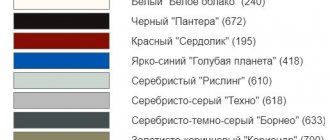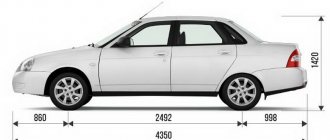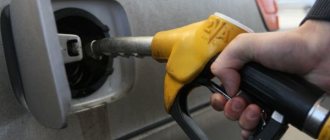Among the entire list of technical characteristics of any car, including the Lada Largus, the volume of the fuel tank is of significant importance. This parameter characterizes the vehicle’s ability to move autonomously.
Some inquisitive owners of the popular Lada Largus station wagons smell the manufacturer's trick in terms of the actual tank capacity in comparison with the declared value.
How does this happen? Let's look at our material.
Characteristics
Engines for Largus are 1.6-liter gasoline.
Their power is low: the eight-valve unit has 87 hp. at 5100 rpm (140 Nm), and for a sixteen-valve engine - 106 hp. at 5800 rpm (148 Nm). But both absolutely easily “digest” inexpensive 92-octane gasoline, which is, of course, very important in Russian realities. According to the manufacturer, average fuel consumption ranges from 7.9 to 8.2 liters. per 100 km, which, judging by numerous test drives and reviews from car owners, is practically no different from the truth. Any of the engines is combined with a non-alternative five-speed manual transmission, and there are no modifications with automatic transmission yet.
Review of LADA Largus van CNG
LADA Largus van CNG. Will take over everything
LADA Largus CNG van is created on the well-proven B0 platform of the Renault-Nissan-Mitsubishi Alliance, which provides for the possibility of using a wide variety of power plants - this potential was laid down during the design process of the vehicle.
LADA Largus CNG New energy
Reliable suspension, high ground clearance and good geometric cross-country ability are confident arguments against surprises on roads and directions.
Interior: convenience in every detail
LADA Largus van CNG is a modification that allows the use of two types of fuel: compressed natural gas (methane) and gasoline, which significantly increases the commercial efficiency of the vehicle.
Important benefits
Commercial version of Largus for professionals looking for practicality, convenience and economic value. Reliable and durable, it exhibits high load capacity and capacity. In the LADA Largus van, everything is done for ease of loading and unloading.
When the gas runs out, the engine power is automatically switched to gasoline.
Gas/petrol switch
located next to the gear shift knob and has a four-level display of the amount of methane in the cylinder.
for filling with gas is located on the right side of the car in the hatch next to the neck of the gas tank.
Safety by design
The installation of gas cylinder equipment (GBO) uses high-quality components from well-known global manufacturers. The fuel supply system uses phased fuel injection with an adjustable intake system with four gas and four gasoline injectors. In order to ensure safety, the gas equipment of the LADA Largus CNG van is equipped with special valves that automatically shut off methane leakage in the event of an accident. The factory LPG kit is certified, fully adapted to the design of the vehicle, which ensures a high level of reliability and safety.
Two front airbags - essential protection for driver and passenger
The ABS system reduces the braking distance of the vehicle and maintains controllability during emergency braking.
Caring for the environment
When operating on methane, the amount of harmful emissions into the atmosphere for individual components is reduced by 2-3 times. The high quality of gas equipment allows Largus CNG to comply with Euro 5+ standards.
Modern economical engines
There are two engines available for LADA Largus, which allow you to choose a car to suit your taste and goals. Powerful and dynamic, 1.6 l (106 hp), 16-valve engine - for high-speed driving, and high-torque, 1.6 l (87 hp), 8-valve - the optimal solution for economical movement of heavy objects .
Declared dimensions
In accordance with the technical documentation supplied with the car with a 16-valve engine, no more than 50 liters of fuel can be filled into its gas tank. Taking into account the standard fuel consumption, this number of cars is enough to drive without refueling:
- along city streets - 450 kilometers;
- on the highway - 700.
However, the actual size of the gasoline tank on Largus is slightly larger than what the manufacturer indicates.
In particular, some owners managed to fill it with up to 65 liters of fuel. This circumstance causes some confusion among many. In most cases, car enthusiasts are enthusiastic about this discovery, because the extra amount of fuel allows them to increase their range by one and a half to two hundred kilometers.
Declared parameters
According to the manufacturer's manual, Russian station wagons equipped with a 16-valve engine head design have a fuel tank capable of “taking on board” 50 liters of fuel. Following the stated consumption rates, this volume will be enough to overcome:
- in urban mode – 450 km;
- on country routes – about 700 km.
In fact, the actual volume of the fuel tank in the Lada Largus is slightly larger compared to the capacity declared by the manufacturer. Particularly gifted owners managed to fill the station wagon's tank with up to 65 liters. This course of events baffles many researchers, but does not upset anyone, since there is no subject for whom a few additional liters of fuel would become superfluous.
How to find out the actual volume of the gas tank yourself?
If desired, the driver of a Lada Largus can independently determine the volume of his fuel tank with an accuracy of one liter.
Lada Largus filler neck
Very little is needed for this purpose:
- The actual car.
- Canister with special displacement marks.
- Petrol.
You must proceed as follows:
- First you need to completely empty the fuel tank. Either drive around the gas station until the fuel runs out, or pump it out using a special pipe.
- Next, fill the tank to a nominal volume of 50 liters. In fact, taking into account the error of the fuel equipment, there will be from 50 to 409 liters of fuel in the tank. The error itself is not very large and does not affect the purity of the experiment. Therefore, we close the gas tank and drive away from the gas station to a safe distance.
- Now we will need pre-prepared canisters with displacement marks. It is desirable that they be metal. Using plastic in such matters can be dangerous, as it may cause a spark and, as a result, a fire. If everything is in order, start slowly and carefully pouring fuel from the canister into the gas tank until you see that it is full to capacity.
- The main thing is not to rush, remember about the voids in the gas tank. Which fill up gradually. As soon as you see the fluid level, wait a few minutes and then continue adding fuel.
As a result, at the end of the experiment, the Lada Largus fuel tank should contain approximately 60–62 liters of gasoline, in some cases up to 65.
Safety requirements
This is the most likely reason. The thing is that gasoline, like any liquid, has certain physical properties that cannot be ignored. It itself is very volatile. Even at relatively low temperatures, fuel vapors are actively formed. It is for them that the tank is made large in size. If expansion is not taken into account, then the likelihood of the mixture exploding increases. To prevent such a sad outcome, the tanks are equipped with special recesses. When filling to capacity, these cavities are also filled, which does not happen if only the standard 50 liters are poured into the container.
Design aspects
Now regarding the tank capacity indicated by the manufacturer, equal to 50 liters. The plant, based on its own decisions, did not declare the tank capacity parameter, which was 15 liters higher than the declared value.
New Lada: Trade-in for Lada Largus Cross from 1.9% without down payment, buy a new Lada Largus Cross at Trade-in, car dealership, Moscow
Note that the tank in almost any car can accommodate a volume of fuel in excess of the stated norm. This occurs due to the peculiarities of accounting for the useful filling volume. So the developers do not take into account the neck of the tank. In Lada Largus this element is quite voluminous and can hold about 3 liters.
The legal aspect should not be discounted when manufacturers deliberately underestimate most of their regulated technical parameters of their models. If any of the parameters indicated in the documentation actually turns out to be lower, then the manufacturer risks facing a lawsuit from an angry buyer.
Armrest in Largus
Replacing timing belt Largus 16 valves
Railings for Largus
Inaccuracies in gas station measuring equipment
It is not recommended to discount this existing aspect. Even eminent fuel suppliers and refillers suffer from underfilling, let alone small stations. Official warnings from refueling companies indicate that there is an underfill of around 50 ml for every 10-liter portion that gets inside the Lada Largus tank. What is happening in reality can only be lost in conjecture.
Lada Largus fuel tank volume: capacity, how many liters
Among the entire list of technical characteristics of any car, including the Lada Largus, the volume of the fuel tank is of significant importance. This parameter characterizes the vehicle’s ability to move autonomously.
Some inquisitive owners of the popular Lada Largus station wagons smell the manufacturer's trick in terms of the actual tank capacity in comparison with the declared value.
How does this happen? Let's look at our material.
Determine the volume yourself
To find out how much fuel your car's gas tank can take, just do the following:
- go to the gas station with as empty a tank as possible and take an extra canister with you;
- buy exactly 50 liters of gasoline and fill it into the tank;
- fill the canister again.
As mentioned earlier, the accuracy of metering devices at gas stations is quite conditional, but most likely the discrepancy will not be more than a liter. This is not of fundamental importance for the experiment.
Drive the car with a full tank away from the gas station, open the tank and start pouring fuel stored in a metal canister with a scale into it. If you don’t have one, then take with you, for example, a measuring cup or a liter jar.
The main task is to fill the container under the lid. Pour gasoline slowly so that it has time to flow into the previously mentioned sinuses.
Most likely, you will be able to increase the fuel volume to 60 or even 62 liters. But don’t get too excited – it’s quite harmful for a car to drive with an overfilled tank. If you use the volume to its fullest all the time, the container will soon become unusable - it will be damaged by too much internal pressure created by the gases.
Reasons for increased gas tank volume
When compiling technical specifications for the Lada Largus, the manufacturer made a significant mistake in the volume of the fuel tank. In practice, many motorists managed to fill up to 65 liters of fuel at once, which makes it possible to drive almost a thousand kilometers outside the city limits at one gas station.
The reason for this dissonance, as it turned out, is on the surface, and there are several of them at once:
- Quite wide and long neck of the gas tank.
- Special voids in the fuel tank created to increase its wear resistance.
- Inaccuracies in the operation of meters at gas stations.
- In addition, some gas tanks may differ slightly in design. However, in order for them to comply with the technical documentation, the manufacturer declares a deliberately smaller volume.
Each of the points increases the tank volume by at least 1–2 liters. Why? Let's take a closer look.
FakeHeader
Comments 21
Volkswagen Polo fuel tank volume: let's describe the main thing
The tank is exactly 50 liters - tested on a stalled car by filling it up to the neck. And they simply inject you with gasoline. All tanks are the same, because... in the molds of a part such as a tank, there cannot be an error of more than 100 grams.
After a full tank, when the first light goes out
somehow I didn’t notice, but if on the highway it takes a very long time, and then abruptly. This is an incorrect operation of the on-board driver. just like when parking on a slope or with the car running, refuel.
I've driven 200 km through the city in Japan and not a single stick has fallen yet
The tank is exactly 50 liters - tested on a stalled car by filling it up to the neck. And they simply inject you with gasoline. All tanks are the same, because... in the molds of a part such as a tank, there cannot be an error of more than 100 grams.
Golimaya nonsense, the tank on the Largus is under the throat, about 65 liters, I measured it myself with a canister!
It’s strange, when I have 9-10 liters left (according to BC), 40 liters can hardly fit in. If the remainder is 11, then about a liter does not fit, it snaps off and flows from the neck along the wing.
Not quite on topic, but about gasoline... Please tell me guys who has tried experimenting with adding acetone (methyl butyl ether), alcohol (isopropyl), MPBE (methyl tert-butyl ether) to gasoline? There are legends that, for example, with the addition of 0.5/50 acetone to the fuel (alcohol and MPBE have their own proportions) you get an increase in power (idles work more smoothly and overtakes willingly (0.3 sec you gain at 402m (quarter))) environmental friendliness (due to the crazy octane number, the fuel burns softly and completely) efficiency (you can watch the consumption on YouTube without and with acetone) and the entire fuel system remains like new, including the spark plugs (there is no soot left, which indicates high-quality fuel combustion in the combustion chamber) , alcohol (only isopropyl, and not ethyl or methyl) acts almost the same as acetone (both also act as a chain between water and gasoline, which is important when there is condensation in the tank and not only in the tank), but a little weaker, and MPBE, in addition to all the bonuses, they say the exhaust will smell like wormwood (by the way, for example, more than once I noticed such a smell on Lukoils when filling up with 95 (I didn’t feel such a smell at 92) ... But you only need to stir 92 (it is cleaner and without the intervention of crooked hands, as they say) well, observing strict proportions so that what is useful does not become harmful... All other additives such as naphthalene, manganese, ferrocene and tetraethyl lead were used by tycoons 90 at left-handed gas stations for their own benefit only. I also want to try mixing 92 with acetone, alcohol and MPBE, what do you think? The volume of a vehicle's gas tank is included in the list of its main technical characteristics
In particular, such an important indicator as autonomous range depends on this parameter.
The volume of a vehicle's gas tank is included in the list of its main technical characteristics. In particular, such an important indicator as the autonomous power reserve depends on this parameter.
However, the owners of the Lada Largus suspect that the volume of its fuel tank does not correspond to the dimensions declared by the Volzhsky Automobile Plant. We will explain why this happens below.











